EV charging stations have developed into a significant component of municipal infrastructure in numerous places. Many homeowners and landlords also decide to install independently run charging stations. Both are crucial for achieving enough infrastructure coverage, and both must adhere to local laws and standards and meet technical specifications to guarantee a hassle-free charging process.
The main objective is to make the charging infrastructure safe by removing any potential for fire, electrocution, or other problems. This is accomplished through careful testing, where DEKRA safety management steps are our focus with EV charging stations and infrastructure testing.
This is accomplished through careful testing, where DEKRA safety management steps are our focus with EV charging stations and infrastructure testing. This entails planning for risk protection and cooperation amongst all key players, such as charge point operators, manufacturers and car OEMs, installers, local governments, and energy providers.
Dangers of electric vehicle charging stations

There are now lots of options than ever for businesses looking to switch to cleaner, greener, and more sustainable transportation for their employees. EV sales are now on pace to surpass those of gas-powered vehicles shortly.
Using electricity, a renewable energy source, as opposed to fossil fuels like gas and diesel, has many positive social and environmental effects. However, to prevent loss, damage, and harm to their users, the high voltages required to charge and run these vehicles offer risks that must be controlled.
The Risk: Fires in Electric Vehicle (EV) Charging Stations

Many technologies that, just a few years ago, were thought to be futuristic or, at best unique have now been adopted and accepted globally due to the growing concern over climate change and reducing the amount of carbon released into the environment. One such innovation is the electric vehicle (EV).
The industry anticipates significant increases in EV deliveries, and EVs are quickly becoming commonplace on roadways throughout the globe. Bloomberg predicts that electric vehicles will increase dramatically, from 3 million in 2020 to 66 million in 2040. The latter astonishingly represents two-thirds of the world’s auto market.
The latest models include a battery storage system with two charge outlets. Therefore, all of these vehicles will need a charging station. The cars need a charging station network when they move from point A to point B. EV charging is evolving into its sector of the economy. EV charging will have a USD 6.8 billion market by 2021. With a cumulative annual growth speed (CAGR) of 38%, it is anticipated to surpass USD 20 billion by 2025.
The abundance of charging stations that are entering the market entails some concerns. Mistakes are bound to arise in fires because EVs and charging stations communicate with high-voltage power. Although they are not currently prevalent, fires during charging have happened (see one here), and since the number of EVs is expected to rise, this is likely to happen more frequently.
While analyzing the fire risks related to EV charging, numerous factors need to be considered. The charging system itself is the first factor. EV chargers are just as prone to fire as any other electrical equipment. Their security and safety mainly depend on the calibre of the wiring and other parts and the installer’s skill. Particularly about home chargers, this is true.
Ineffective or obsolete wiring has the potential to short circuit, arc, and/or overheat, all of which can cause a fire. The ground fault circuit interrupters utilized in these systems also have a famously high failure rate.
What makes an EV home charging station safe?

As we’ve seen above, charging an electric automobile can be dangerous incorrectly. So how does a specific home charging station stop these? Let’s examine several features of a home charger that make it much safer to use than a typical home outlet.
• Designed to carry high loads
Instead of a regular outlet or extension cord, a home EV charging station is specifically created and plugged into your house to accommodate the heavy demands of EV charging. It frequently has a direct connection to your meter box and its special circuit breakers, which adds an extra layer of security and permits it to securely draw more oversized loads.
• Impact-proof and durable
Home charging stations are robust and can survive numerous shocks and impacts without being harmed in addition to withstanding the outdoors. A home charger’s cable is much thicker and more durable than an extension cord, which might easily be broken if someone drives over it.
The durability of home charging stations is rigorously tested before they are approved for use. Before they can be marketed, charging stations, for instance, must pass many international certifications, such as those from the International Electrotechnical Commission (IEC) or Underwriter Laboratories (UL). Before going on sale, these certifications confirm that the charging station has undergone extensive safety testing at a certified independent lab, like TÜV Rheinland, DEKRA, or SIQ.
• Smart charging
Via smart charging systems, the software can improve home charging, among other things. Dynamic load balancing is one of many clever characteristics under “smart charging,” a word used interchangeably. Without going into too much technical detail, this feature automatically modifies the power consumption of your charging station in reaction to variations in power usage in your home.
For instance, dynamic load balancing might choose to pause or slow the charging of the EV to make room for the other appliances if a washer, a dryer, and a dryer are all turned on simultaneously. When they are turned off, the charger restarts or quickens the EV’s charging process. Smart charging makes Several efficiency opportunities possible, but they all hinge on connectivity. Most contemporary chargers are equipped with internet connectivity, and there are already rules – such as in the UK and EU – that specify particular connectivity criteria.
How to Reduce the Dangers

• Electric shocks
Electric shock danger can be considerably decreased at charging stations by performing routine cable insulation, plugs, and wiring maintenance. We advise understanding what to do in an emergency if someone receives a high-voltage electric shock because electric shocks do occur to lessen the severity of injuries. You can decrease your chance of injury by taking additional basic electrical safety precautions, like wearing shoes with rubber soles.
To safeguard yourself and the people around you, you should notify a staff member immediately of any accident or damage to equipment at public charging stations, whether it was caused by you or someone else.
• Tripping on charging cables
Use wires the exact length you need to avoid coiling and twisting, which could grab a foot or leg and cause a fall. Invest in a cable protector if you must run your cable across a path or carriageway so people can converse. At the same time, it is protected from damage and exposed to an elevated fire or electric shock risk. Consider carefully where the charging station should be installed to minimize trip hazards if you use a personal home charger before installing it.
Conclusion
The lack of infrastructure to support this emerging technology is a contributing factor. Although there are more public charging stations in cities worldwide, many individuals still choose to use home chargers since they are more convenient and cheaper, even if each comes with its own set of risks.










